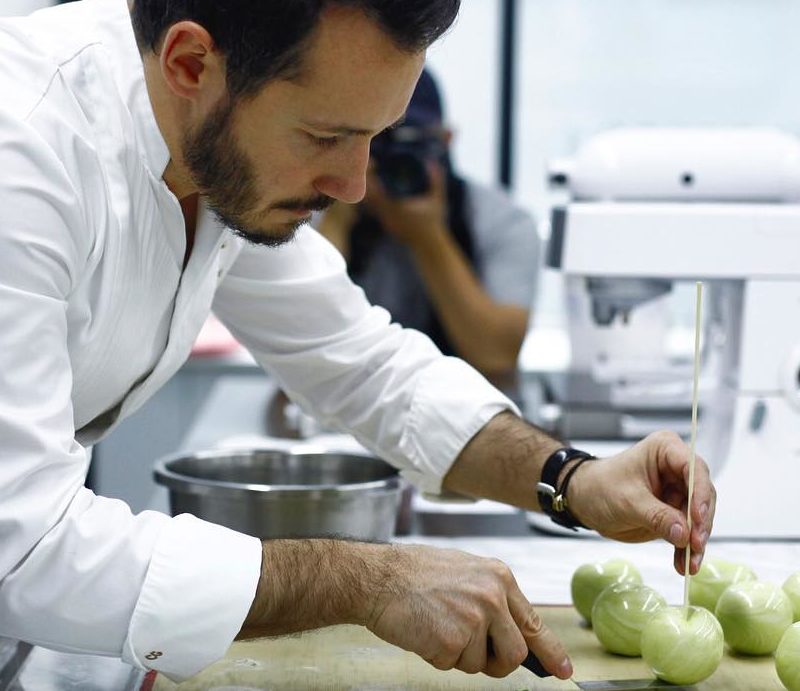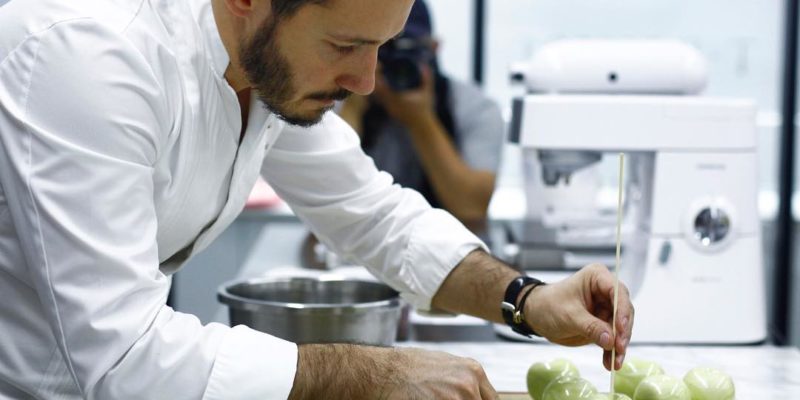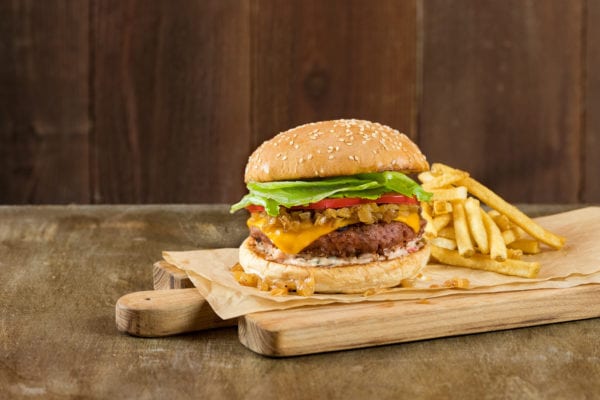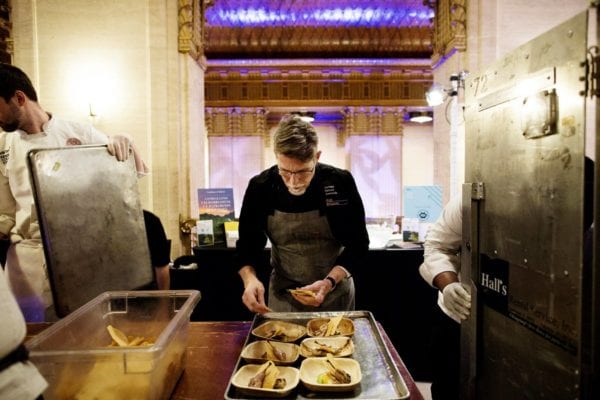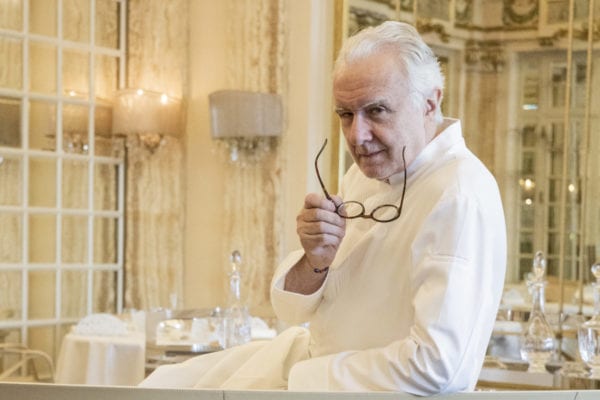Skift Take
There's not a great deal of room to experiment at the top of French cooking. Perhaps it will be a pastry chef that shows them it's possible to think beyond the limits of tradition.
— Jason Clampet
An apple is an apple by any other name. Except when it’s a dessert by Paris’s hottest pastry chef.
Cédric Grolet is known for his striking trompe l’oeil creations. What looks like a fig or lemon is actually an impossibly thin shell of lacquered white chocolate, which cracks open to reveal layers of fluffy ganache and spiced fruit.
Grolet’s devotion to aesthetics and painstaking techniques have won him the title of Best Pastry Chef in the World from Les Grandes Tables du Monde as well as an Instagram following of more than 618,000 people. But the 32-year-old chef is far from complacent.
“I don’t revisit anything.” Grolet says during a visit to his kitchen. “If I pick up a classic French recipe, it’s to see how I can push it forward.” As executive pastry chef of le Meurice since 2013, Grolet has brought a new energy—and a new generation of diners—to one of Paris’s most esteemed palace hotels.
Consider afternoon tea at the Meurice’s Restaurant le Dalí: Each table is greeted with a triple-decker tray of sandwiches, scones, and muffins, plus a sampling of the season’s photo-friendly desserts, signed by Grolet. Right now, that means edible sculptures depicting gleaming candied apples spiced with juniper berry and nubby lemons made of white chocolate and mint cream. At a time more often reserved for client meetings and traveling couples enjoying their golden years, the ladies who lunch are now joined by a fresh-faced, fashionable set that has been little interested in the lengthy, wallet-busting gastronomic meals typical of the city’s five-star hotels.
In the evening, yes, guests can still work their way through a two Michelin-starred dinner by Alain Ducasse before getting to Grolet’s dessert—or they can mix high and low. Just as today’s Parisian might pair a Uniqlo t-shirt with a Chanel handbag, nothing’s stopping you from following up ramen at a dive-y Japanese bistro with drinks and signature dessert at Le Meurice’s bar.
Beyond the visual appeal of his desserts—a search for #tarteauxpommes (French for apple pie) on Pinterest or Instagram brings up hundreds of reposts and imitators for Grolet’s star-making version of the dish, in which thinly sliced apples are twisted into the shape of a rose—the chef is hardly neglecting taste. He aims to preserve the original flavors of a fruit, not to mask them with sugar and butter.
“I want to respect the product that nature gives us. I look for simplicity.” Grolet says. He prefers to pair a fruit with the right herb or spice to set it off. “It’s important to me that the clients understand what they’re tasting.” (His first photo and cookbook, released last month, is aptly and simply named: Fruits).
That isn’t to say simplicity is easy: Grolet and his staff of up to 25 chefs and apprentices spend their days peeling and dicing, juicing and reducing in order to concoct intensely flavored fruit solutions before sculpting each cream-and-white chocolate shell by hand.
While Grolet has seized the international spotlight, he is just one of a new guard of pastry chefs shaking up the dessert scene in the French capital that long gasped under the weight of a million multicolored macaroons.
“Pastry is having a really important moment now,” says Christine Doublet, head of editorial content of the food guide and app, le Fooding. Whether it’s by experimenting with unexpected ingredients, or daring to spurn the traditional line-up of eclairs and tartes fines, “people are breaking away from classicism in a lot of different ways.”
That includes stepping out from Paris’s grand dame hotels and moneyed central neighborhoods, where such chefs as Pierre Herme and Sebastien Gaudard built their careers, and opening up pastry shops in the hipper eastern quarters. Moko Hirayama departed the 1st arrondissement and the top-end Japanese restaurant Yamtcha to open her own café, Mokonuts, east of Bastille, a neighborhood that’s become popular with the strain of upwardly mobile hipsters and hard-rocking aristocrats known in France as the bo-bos (bourgeois bohemians).
Hirayama bucks structured, decorative desserts in favor of a more homespun approach. She represents an opposite trend from Grolet: Her crusty almond cakes and chunky chocolate chip cookies are among the dowdiest in Paris, but they are served to great acclaim. Most everything is organic, too. Take a look at the thirtysomething freelancers dropping crumbs in their beards, and that should go without saying.
Yann Couvreur, the former pastry chef of both the Prince de Galles and Park Hyatt, has set up his eponymous pâstisserie in a no-man’s land between the Place de la Republique and Belleville, nestled among Turkish kebab shops and hawkers of fake Versace. Couvreur, like Grolet, has worked to drastically reduce the amount of sugar and butter in his versions of classic French pastries like millefeuille and baba au rhum, turning instead to fresh fruits and more exotic ingredients borrowed from savory cuisine, such as yuzu and buckwheat, to make sure the desserts still pack a punch.
Myriam Sabet is also betting Parisians will open their minds and palettes to new flavors. At Maison Aleph, the Franco-Syrian sweet shop she opened in the Marais last summer, Sabet serves up bite-sized “nests” filled with cream infused with such flavors as sumac, orange blossom, and rose.
“People who visit from around the world have great restaurants in their home cities, but France remains superior when it comes to pastry,” says Sabet, a former trader at Société Générale. In other words, the booming business of sweet shops in Paris is about playing up an area in which France’s primacy remains unchallenged. The fact that clients have the chance to eat fine meals when they travel somewhere else helps to reinforce Paris’s pastry boom. Visitors who land in the City of Light are more and more likely to focus on dessert.
With the Christmas season around the corner at le Meurice, lemons and candied apples will soon give way to Grolet’s version of the Yule log (last year, he sculpted individual rolls into golden chestnuts the size of a fist) and to his latest recipe, the mandarin orange. When I met Grolet in the labyrinthine kitchens of le Meurice, it was more than a week before the dessert was scheduled to appear on the menu, but his assistants were already peeling, juicing, and chopping their way through several crates of the fruit—working on what would end up being the fruity concoction at the center of the dish.
“It’s the best dessert I’ve tasted in a long time,” Grolet says, as if it were a matter of fact.
©2017 Bloomberg L.P.
This article was written by Robert Williams from Bloomberg and was legally licensed through the NewsCred publisher network. Please direct all licensing questions to [email protected].
![]()

